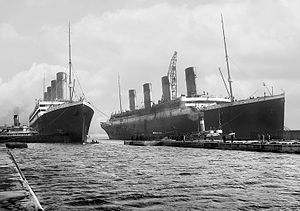Olympic class liner

Belfast, Northern Ireland, 6 March 1912: Titanic (right) moved out of the drydock to allow her sister Olympic to replace a damaged propeller blade.
|
|
| Class overview | |
|---|---|
| Builders: | Harland and Wolff, Belfast, Northern Ireland |
| Operators: |
|
| Preceded by: | Big Four |
| Succeeded by: | RMS Homeric; RMS Majestic |
| Subclasses: | 2 |
| Built: | 1908–1914 |
| In service: | 1911–1935 |
| Planned: | 3 |
| Completed: | 3 |
| Lost: | 2 |
| Retired: | 1 |
| General characteristics | |
| Type: | Titanic's dimensions used as all three vessels' dimensions were slightly different |
| Tonnage: | 45,000 - 48,000 gross |
| Displacement: | app. 52,310 tons |
| Length: | 882 ft 9 in (269.06 m) |
| Beam: | 92 ft 6 in (28.19 m) |
| Height: | 175 ft (53 m) from keel to top of funnels |
| Draught: | 34 ft 7 in (10.54 m) |
| Depth: | app. 64 ft 9 in (20 m) from keel to side of C-deck |
| Decks: | 9 (all three liners); 7 for passengers |
| Installed power: | 24 double-ended and 5 single-ended 15 bar Scotch marine boilers, tested to 30 bar. Two 4-cylinder reciprocating engines for the two outboard wing propellers. One low-pressure turbine for center propeller. Together 50,000 HP nominal, 59,000 max. |
| Propulsion: | consisting of Two bronze 3-blade wing propellers. One bronze 4-blade centre propeller. |
| Speed: | 21 kn (38.9 km/h; 24.2 mph); 24.2 kn (44.8 km/h; 27.8 mph) max. |
| Capacity: | 3,295 passengers, officers, and crew |
| Crew: | 944 crew members (maximum) |
| Notes: | Approximate cost 7.5 million (USD) (approx. $199,385,678.65 in 2016 prices) |
The Olympic-class ocean liners were a trio of British ocean liners built by the Harland & Wolff shipyard for the White Star Line during the early 20th century. They were Olympic (1911), Titanic (1912), and Britannic (1914). All three were designed to be the largest and most luxurious passenger ships in the world, designed to give White Star an advantage in the transatlantic passenger trade. Two were lost early in their careers: Titanic sank in 1912 on its maiden voyage, after hitting an iceberg in the North Atlantic Ocean, and Britannic in 1916, after hitting a mine laid by the minelayer submarine U-73 in a barrier off Kea in the Aegean Sea during World War I. Olympic, the lead vessel, had a career spanning 24 years and was retired in 1934 and sold for scrapping in 1935.
Although the two younger vessels did not have successful careers, they are among the most famous ocean liners ever built. Both Olympic and Titanic briefly enjoyed the distinction of being the largest ships in the world; Olympic would be the largest British-built ship in the world for over 20 years until the launch of RMS Queen Mary in 1936. Titanic's story has been adapted into many books and films. Britannic has also inspired a film of the same name.
The Olympic class had its origins in the intense competition between the United Kingdom and Germany in the construction of the liners. The Norddeutscher Lloyd and HAPAG, the two largest German companies, were indeed involved in the race for speed and size in the late 19th century. The first in service for the Norddeutscher Lloyd was SS Kaiser Wilhelm der Grosse, which won the Blue Riband in 1897 before being beaten by Deutschland of HAPAG in 1900. Then followed the three vessels of the Kaiser Wilhelm der Grosse: SS Kronprinz Wilhelm, SS Kaiser Wilhelm II and SS Kronprinzessin Cecilie all of whom were part of a "Kaiser class". In response to this, the Cunard Line of the UK ordered two vessels whose speed earned them the nickname "greyhounds of the seas:" Lusitania and Mauretania.Mauretania kept the Blue Riband for more than twenty years, from 1909 to 1929.
...
Wikipedia
